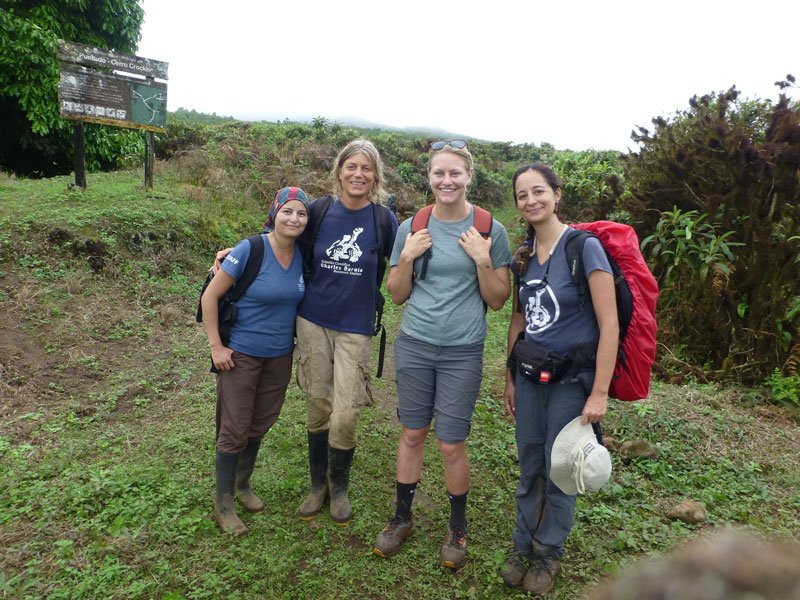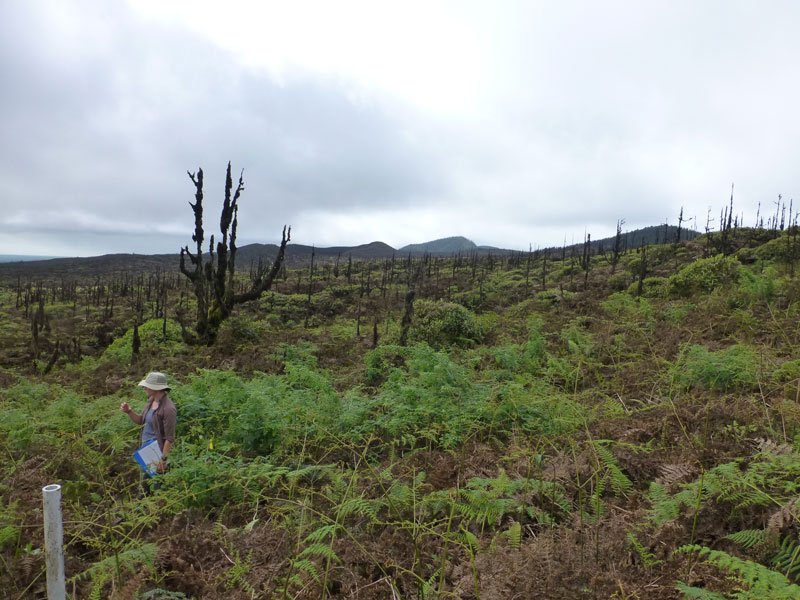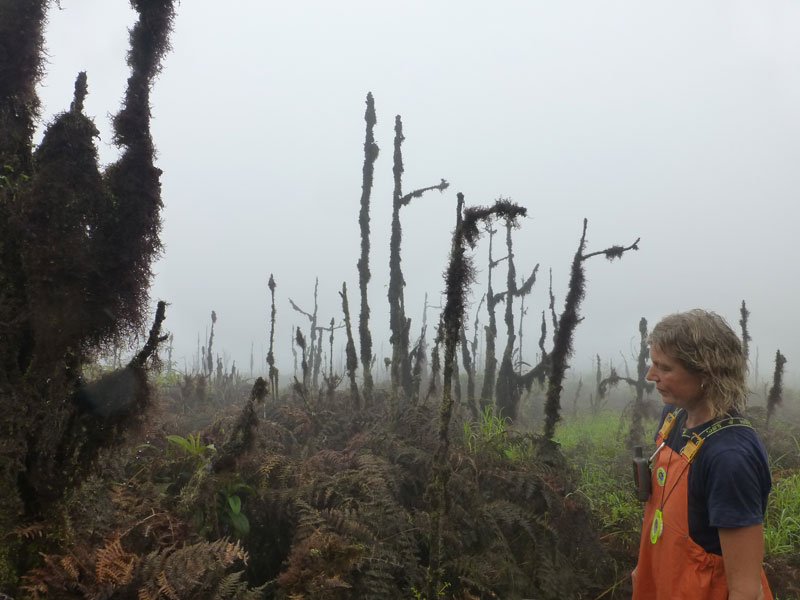In the humid highlands of Santa Cruz Island, just north of the village of Bellavista, a dirt road meanders through coffee and sugarcane farms before coming to a dead end at the trailhead to Media Luna, named for the half-moon shaped volcanic crater that stands guard over the park entrance. Here lies the “buffer zone”, a 3-meter wide mowed strip of bare ground that divides the island’s designated agricultural zone from the surrounding protected area within the Galapagos National Park. Standing at this artificial edge, we observe a sharp contrast between two kingdoms: humans on one side, nature on the other.

The purpose of the buffer zone is to deter the spread of non-native plants into the National Park area; but as is often the case in conservation, the real divide between people and nature at Media Luna is a messy story. Starting in the late 1800s, agricultural development has dramatically altered the state of highland ecosystems on the islands in Galapagos that are inhabited – even in areas supposedly untouched by humans. Indeed, the Charles Darwin Foundation (CDF) and collaborators estimate around 1500 introduced species have been established across the archipelago since the start of human settlement (about 1832), 810 of which are vascular plants. The vegetation beyond the buffer zone at Media Luna has been modified over the last century by grazing disturbance, fire, and the rise and fall of a highly invasive tree, red quinine (Cinchona pubescens). This place has withstood changes that, if captured in an aerial time-lapse video and played at 2000x speed, would tell a saga epic enough to rival any wildlife documentary. Instead, we rely on data.
When CDF Restoration Ecologist Dr. Heinke Jäger first established long-term monitoring plots at Media Luna in 1998, quinine was on the rise in areas once dominated by the endemic shrub Miconia robinsoniana. Originally introduced as a potential cash crop for its medicinal value, quinine rapidly invaded highland areas outside of the agricultural zone, forming dense canopies in formerly “treeless” environments. The hapless irony here is that malaria has never occurred in Galapagos, the anti-malarial compound which once gave the quinine tree its value is now manufactured synthetically, and Cinchona pubescens would have been the wrong species of quinine for this purpose.

At Media Luna, Heinke’s team showed reduced species richness and altered soil chemistry in plots heavily invaded by quinine. This data proved critical in guiding management decisions by the Galapagos National Park Directorate which has controlled quinine manually and chemically since the 1970s.
If the phrase “long-term vegetation monitoring” doesn’t inspire a boundless sense of thrill and adventure in your heart, you are not to blame. By design, ecological monitoring is a patient, steady, consistent, incremental, repetitive process – in less benevolent terms, it’s boring. Take Media Luna as an example: it takes two people approximately eleven days to monitor thirty-one 20 x 20m plots, each containing five transects, with plant cover recorded in intervals of 10 cm. There are no shortcuts. Year after year, the methodology is the only constant in this shifting landscape.

Beyond just a lack of exciting marketing opportunities, monitoring programs require a commitment to a long-term investment horizon. Smaller institutions, especially ones with intermittent funding sources or high employee turnover rates, may have a difficult time sustaining research at this scale. Many of the programs listed in the National Science Foundation’s Long Term Ecological Research Network receive support from federal agencies or large universities.
Given these challenges, it’s no small accomplishment that the monitoring plots at Media Luna are still alive after twenty-two years. This dataset is not perfect; for example, the time interval between monitoring events varies from 2-6 years. Additionally, we lack information on site-specific environmental variables, such as precipitation and soil chemistry, that might help us understand changes in the plant community on a mechanistic level. Although the CDF maintains a long-term weather station in the nearby village of Bellavista, as any resident of Santa Cruz Island can attest, weather patterns in the highlands exhibit dramatic variability across short distances. Despite these limitations, this is still one of the longest active time-series of vegetation cover in Galapagos – and its value will only increase with time.
During December 2019 and January 2020, the CDF Terrestrial Invasive Species Group returned to the original thirty-one plots at Media Luna for the first time since 2016. It’s clear that the story of this landscape is still being written. Quinine “graveyards” are now a common sight in areas where they once formed dense forests, and endemic species, in particular Miconia, are making a comeback. Part of the quinine-dieoff since the mid-2000s is attributed to manual and chemical control efforts carried out by the Galapagos National Park Directorate. However, this doesn’t explain observed declines of quinine in plots that have not been subjected to control. Thanks in great part to continued data collection in these untouched long-term plots, with the help of experts at the University of Florida we have determined the culprit: the pathogenic root fungus Phytophthora cinnamomi (unpublished data), among the top 100 most invasive species in the world. Exactly how Phytophthora cinnamomi arrived in Galapagos is unknown, but since it is reported in mainland Ecuador – for example, as a disease in avocado plantations – its spores may have been transported here with contaminated produce or by the wind.

Moving forward, the value of long-term research in Galapagos cannot be overstated. Were it possible to predict the future state of an ecosystem with complete accuracy, conservation would be a simple task. Instead, decisions are made in the face of great uncertainty. Both terrestrial and marine communities in Galapagos are in a state of constant flux, forced by natural climate patterns such as El Niño, and by human disturbances such as land development and species introductions. Long term datasets can help reveal underlying “rules” of a biological system that will play forward over the next century of climate change. On long, rainy days in the field, it’s this commitment to the broad picture that keeps us moving forward, one transect at a time.
Acknowledgements
All our research projects are carried out in collaboration with the Galapagos National Park Directorate (GNPD) and we would like to thank the GNPD for issuing research permits and for logistic support. We are able to carry out our long-term monitoring thanks to the support from Galapagos Conservancy, the Lindblad Expeditions-National Geographic Fund and Keidanren Nature Conservation Fund.





